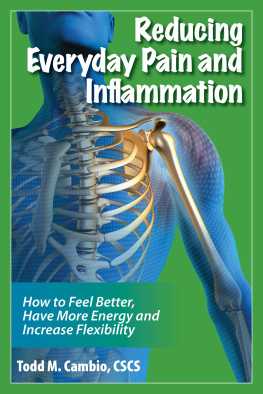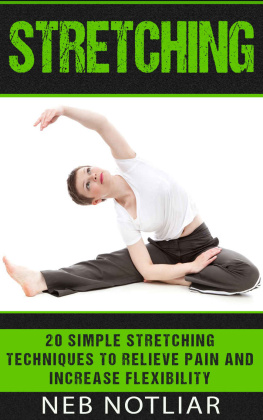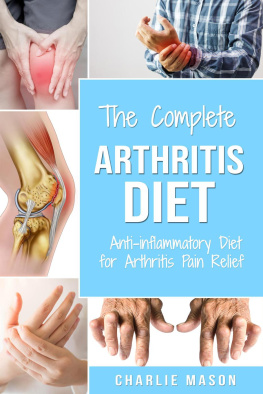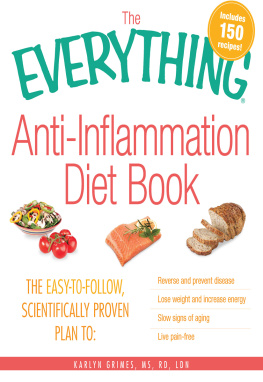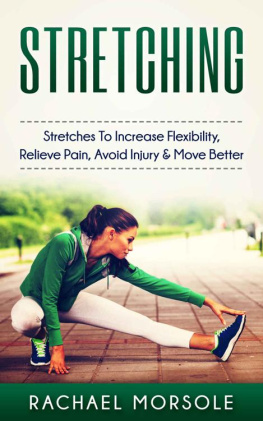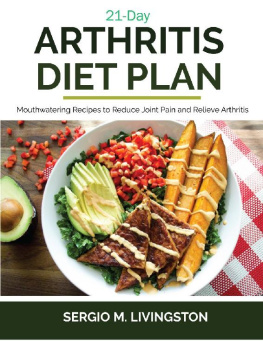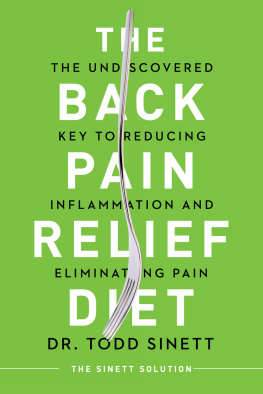Reducing Everyday Pain and Inflammation
How to Feel Better, Have More Energy and Increase Flexibility
By Todd M. Cambio, CSCS

Prior to beginning any exercise program, you must consult with your physician. You must also consult your physician before increasing the intensity of your training. The information in this book is intended for healthy individuals. Any application of the recommended material in this book is at the sole risk of the reader, and at the readers discretion. Responsibility of any injuries or other adverse effects resulting from the application of any of the information provided within this book is expressly disclaimed.
Price World Publishing
www.PriceWorldPublishing.com
Copyright 2011 by Todd M. Cambio
All rights reserved. Neither this book, nor any parts within it may be sold or reproduced in any form without permission.
eISBN: 9781936910199
Biography

Todd M. Cambio, CSCS is the owner of Precision Fitness, LLC in Pawcatuck, CT where he specializes in Sports Performance Training and Human Movement.
He is a Certified Strength and Conditioning Specialist through the National Strength and Conditioning Association as well as a Sports Nutritionist.
Todd holds a BS in Dietetics from the University of Rhode Island as well as a BA in Secondary Education and Biology from Rhode Island College.
For over 10 years Todd has been educating athletes on fueling tactics and training modes for optimal performance. He was a high school biology teacher from 1999-2007, a high school football coach from 2000 2004 and a high school Strength and Conditioning Coach from 2005 2008 before opening Precision Fitness.
Todd is a former college football player and nationally ranked BMX racer. His passion for athletics and sports nutrition led him in the direction of sports performance training. Athletes train hard and tend to have lots of pain and inflammation. So Todd searched for methods that would help his clients heal faster, feel better and perform better. He now teaches these strategies to adults, as well as athletes, who want to look and feel better all the time.
Introduction
After years of training clients of all abilities, there seems to be one common trend, we all get sore and have some pain along the way. There now seems to be a shift towards longer bouts of pain and inflammation with ALL people.
Maybe I just pay better attention to what people are saying or maybe there is a shift in our society towards a sedentary lifestyle that is wreaking havoc on our bodies? I do believe we sit too much. We sit at work, in front of a computer, in our cars commuting to and from work, in front of the TV and while playing video games. We sit much more often than in the past. Keep in mind, our society is larger (over weight and obese) than it has ever been. The food supply has more chemicals and less nutrients than ever before and I havent even mentioned the portion sizes that are out there today. I cant say I have all the answers, but I will offer some solutions.
Reducing Everyday Pain and Inflammation is a book that will help you take control of your body and help it heal, recover and rejuvenate.
Enjoy,
Todd M. Cambio, CSCS
Table of Contents
Why is Recovery and Rejuvenation Important?
- You will feel better.
- You will have less tightness and soreness.
- You will recover faster from lifes activities
- You will have less down time due to illness.
- You will reduce your chance of injury
- You will reduce pain & inflammation in the body

What causes these risk factors?
1. Limited Range of Motion
i. Muscle Imbalances
- In simple terms, a muscle imbalance occurs when you have overdeveloped and tight muscles in one area of your body while the opposing muscles are weak and stretched out of their normal position. These imbalances can happen anywhere on the body and often develop as the result of the routine things you do while on the job, playing sports, or engaging in other activities you enjoy.
- Here are just a few conditions that can develop as a result of muscle imbalances: IT band syndrome, SI joint syndrome, sciatica, frozen shoulder, knee pain, hip pain, fibromyalgia and all forms of back pain.
ii. Poor Posture
- As your muscles get more and more out of balance, you end up pulling yourself out of proper alignment. Once a postural dysfunction has developed, your body cannot go on for long this way before you will begin to experience problems.
| Inflammation is the natural healing process in response to illness or injury which results in heat, swelling and pain. |
| i. | Environmental hot or cold weather, noisy or visually stimulating surroundings, tobacco smoke, excessive alcohol consumption, infectious agents, reactions to drugs, allergens, altitude, and foods including produce, meats, grains, and ingredients used to make various products grown without the use of potentially harmful pesticides, chemical fertilizers, antibiotics, or growth hormones. |
| ii. | Emotional - work, kids, finances, practice, academic, performance, personality types (Type A), disrupted sleep patterns, etc. |
| iii. | High Sugar Diets highly oxidative in nature in the body, causes free radicals. |
| iv. | High Fat Diets - oxidative in nature in the body, causes free radicals |
| v. | Processed Foods high in both fat and sugar and possible chemical dyes. Lack anti-oxidants, fiber, and anti-inflammatories. |
| vi. | Being Overweight accumulation of adipose tissue. Extra body fat causes stress and inflammation on all the bodys major systems (circulatory, lymphatic, skeletal, muscular, hormonal, etc.). |
| Stress Response to emotional or physical threats, whether real or imagined. |
| i. | Accumulation of all these stressors can, at times, be too much for your immune system to handle. |
| ii. | First sign of the bodys inability to cope with stress and inflammation is upper respiratory problems. |
| iii. | More advanced manifestations of unchecked stress have been linked to eating disorders and depression. |
| Disease Unchecked inflammation and stress that persists over time could lead to: |
| i. | Chronic fatigue, pain, heart disease, hypertension, diabetes, cancer, and a host of auto-immune diseases. |
How to Deal with These Risk Factors?

